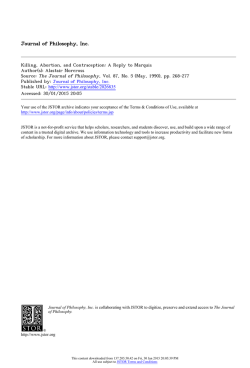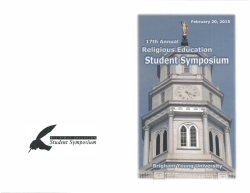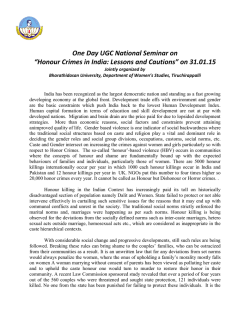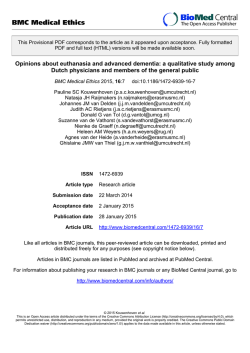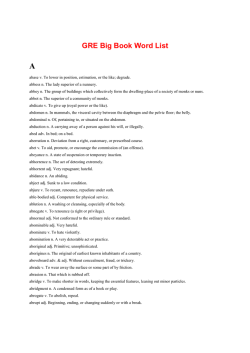
Lecture Notes James Rachels, “Active and Passive Euthanasia
Lecture Notes James Rachels, “Active and Passive Euthanasia” (1975, 1997) Keith Burgess-Jackson 28 January 2015 1. Biography. James (Jim) Rachels was born in Columbus, Georgia, on 30 May 1941. He died (of cancer) in Birmingham, Alabama, on 5 September 2003, at the age of 62. He earned a B.A. degree at Mercer University (Macon, Georgia) in 1962 and a Ph.D. degree at the University of North Carolina (Chapel Hill) in 1967. He taught at the University of Alabama (Birmingham) from 1977 to 2003. Earlier, he had taught at the University of Richmond, New York University, the University of Miami, and Duke University. His son Stuart is Associate Professor of Philosophy at the University of Alabama in Tuscaloosa, Alabama. His son David is Professor of English at Newberry College in Newberry, South Carolina. According to Stuart (The Legacy of Socrates: Essays in Moral Philosophy [2007], 237), the essay entitled “Active and Passive Euthanasia,” which was originally published in the New England Journal of Medicine in January 1975, has been “Reprinted in roughly three hundred anthologies.” We are reading a revised version of the essay, from James Rachels’s collection, Can Ethics Provide Answers? And Other Essays in Moral Philosophy (1997). Page references are to the 1997 version. 2. The traditional doctrine (of active and passive euthanasia). 1 “[I]t is permissible, at least in some cases, to withhold treatment and allow a patient to die, but it is never permissible to take direct action to kill a patient” (63). This doctrine was endorsed by the American Medical Association (AMA) in 1973, and continues in force. (Read the pertinent provisions.) The doctrine implies that, other things (such as consequences) being equal (ceteris paribus), “killing patients is worse than letting them die” (63). Rachels says that “a strong case can be made against this idea” (63). In other words, Rachels believes that there is no intrinsic difference between killing and letting die, i.e., that the bare difference between the two is morally irrelevant/insignificant.2 “If one is accepted, the other should be accepted as well” (63). Note that the inequality/disparity can be removed in either of two ways: • • Continue to believe that it is permissible to allow a patient to die, but start believing that it is permissible to kill a patient. (This is Rachels’s preferred option.) Continue to believe that it is impermissible to kill a patient, but start believing that it is 1 The traditional doctrine may rest on what Jonathan Glover calls the “acts-and-omissions doctrine.” He writes: “Is it worse to kill someone than not to save his life? What we may call the ‘acts and omissions doctrine’ says that, in certain contexts, failure to perform an act, with certain foreseen bad consequences of that failure, is morally less bad than to perform a different act which has the identical foreseen bad consequences. It is worse to kill someone than to allow them [sic] to die” (Jonathan Glover, Causing Death and Saving Lives [Harmondsworth, England: Penguin Books, 1977], 92-3). 2 There are three distinctions to be drawn. The most general is that between acts and omissions. More specific is that between killing and letting die. More specific still is that between active and passive euthanasia. 1 impermissible to allow a patient to die. (I don’t know of anyone who takes this tack.) 3. The doctrine leads to unnecessary suffering. There are cases (such as that described on pages 63-4) in which AE produces less suffering than PE. “The process of being ‘allowed to die’ can be relative slow and painful, whereas being given a lethal injection is relatively quick and painless” (64). Letting Down’s syndrome babies die (as opposed to treating them or killing them) is “patently cruel” (64). Criticism: The argument begs the question, for it assumes the truth of consequentialism. The proponent of the distinction rejects consequentialism. 4. The doctrine “leads to decisions about life and death being made on irrelevant grounds” (65). When Down’s syndrome babies have obstructed intestines, the doctrine implies that it is morally permissible to let them die but not to kill them. But it’s irrelevant that such babies have obstructed intestines. Either it’s permissible to kill all Down’s syndrome babies (even those without obstructed intestines) or it’s impermissible to let any of them die (even those with obstructed intestines). Skip this argument. 5. Rachels’s argument against the killing-and-letting-die doctrine (my wording; see page 66 for Rachels’s wording): a. If the difference between killing and letting die is in itself a morally important matter, then Jones’s behavior is less reprehensible than Smith’s behavior. b. It is not the case that Jones’s behavior is less reprehensible than Smith’s behavior (i.e., Jones’s behavior is just as reprehensible as Smith’s behavior). Therefore, c. It is not the case that the difference between killing and letting die is in itself a morally important matter (from a and b, modus tollens). The argument is valid, which means that the conclusion follows logically from the premises. The proponent of the killing-and-letting-die doctrine (who rejects c) can either grab the bull by the horn (i.e., reject a) or bite the bullet (i.e., reject b). Note: In saying that Jones’s behavior is less reprehensible than Smith’s behavior, one is not saying that Jones’s behavior is not reprehensible. It may be only a bit less reprehensible. On a scale of 1 to 100, Smith’s killing may have a reprehensibility quotient of 100, while Jones’s allowing to die may have a reprehensibility quotient of 99. This is the “masking or sledgehammer effect” that J. P. Moreland (following Richard L. Trammell, “Saving Life and Taking Life,” The Journal of Philosophy 72 [13 March 1975]: 131-7, at 132) mentions in “James Rachels and the Active Euthanasia Debate,” Journal of the Evangelical Theological Society 31 (March 1988): 81-90, at 89: The fact that one cannot distinguish the taste of two wines when both are mixed with green persimmon juice fails to show that there is no difference between the wines. The taste of the persimmon juice is so strong that it overshadows the difference. Similarly the intentions and motives of Smith and Jones are so atrocious, and both acts are so clearly unjustified, that it is not surprising that other features of their situation (killing 2 versus letting die) are not perceived as the morally determinative factors in the cases. Mill’s Method of Difference: Albert | Betty ----------------|---------------Oatmeal | Oatmeal Toast | Toast Peanut Butter | Peanut Butter Jelly | Jelly Apple Juice | --------------------|---------------Sick | Not Sick Conclusion: Apple juice caused Albert’s sickness. Rachels: Jones | Smith ------------------------|-----------------------Motive: Personal Gain | Motive: Personal Gain End in View: Death | End in View: Death Result: Death | Result: Death Letting Die | Killing ------------------------|-----------------------Reprehensible | Reprehensible Conclusion: No moral difference between killing and letting die. Trammell/Moreland: Occasion #1 | Occasion #2 ------------------------|-----------------------Green Persimmon Juice | Green Persimmon Juice Red Wine | White Wine ------------------------|-----------------------Tastes Bad | Tastes Bad Conclusion: No taste difference between red wine and white wine. (This is a refutation by logical analogy. An argument with the same form as Rachels’s argument has true premises and a false conclusion, which means it is invalid. This shows that Rachels’s argument, too, is invalid.) The remainder of Rachels’s essay is discussion. 3 6. Antilogism (inconsistent set of propositions). a. It is morally permissible to allow a patient to die. b. There is no intrinsic moral difference between killing a patient and allowing a patient to die. c. It is morally impermissible to kill a patient. The AMA accepts a and c but rejects b (or rather, is committed to rejecting b). Rachels accepts a and b but rejects c. 4
© Copyright 2025

